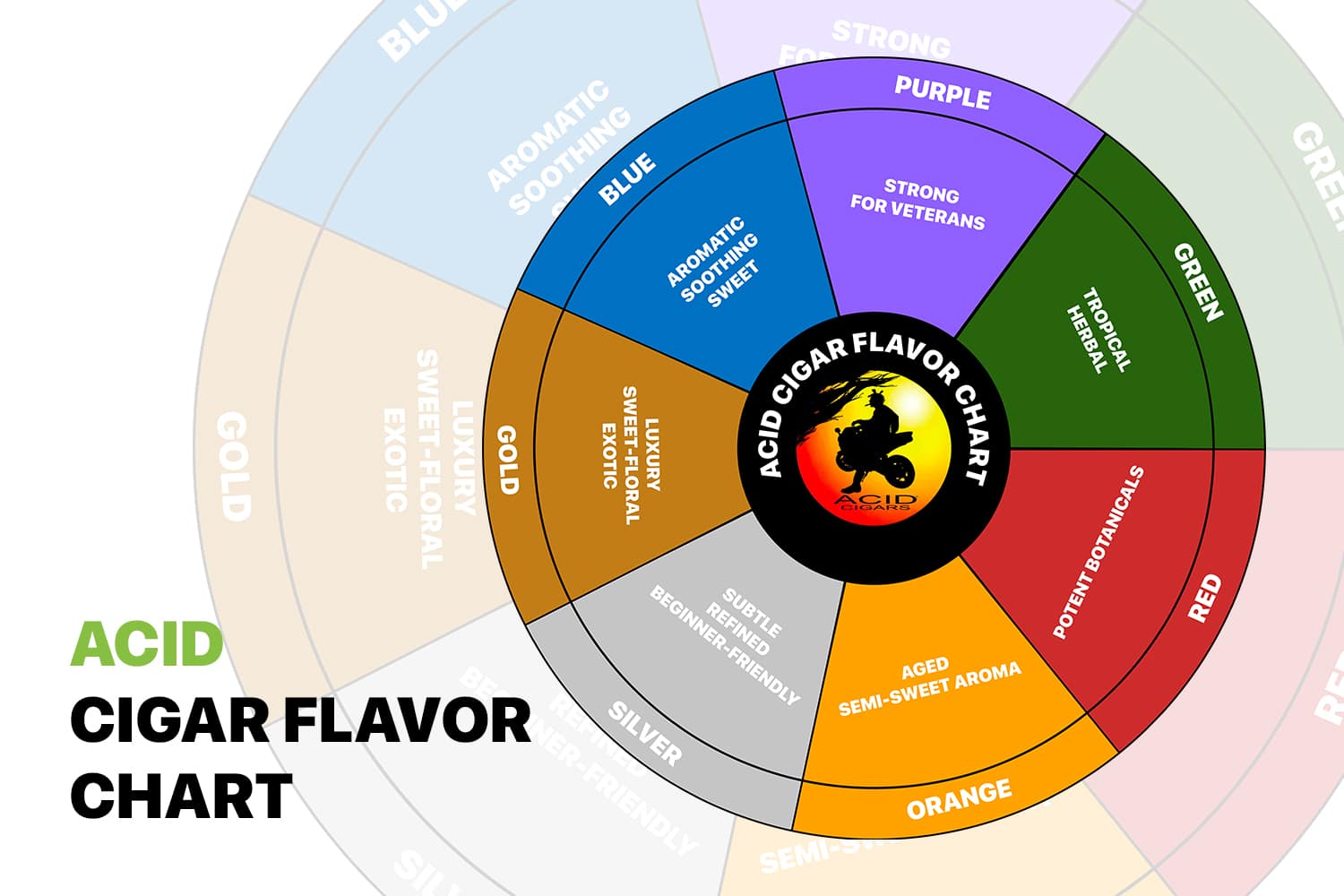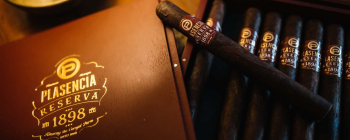
Acid Cigar Flavor Chart: A Guide to Distinctive Aromas and Taste
If you want a cigar with a difference, an Acid cigar is a strong candidate. What is an Acid cigar? No actual acid is involved in its creation. These cigars are made by Drew Estate, a New York-founded brand committed to making its mark in the industry.
Acid cigars comprise more than 140 aromatic compounds, including botanicals, spices, and herbs. As for exactly how these compounds are infused, that remains a closely guarded secret.
In any case, it has helped to cement Acid’s almost cult-like appeal in the cigar space. Another contributing factor is the huge variety of flavors to choose from. On the flipside, distinguishing between these options can be fiendishly tricky.
That’s where the importance of the Acid cigar flavor chart comes in. It provides an at-a-glance look at Acid’s range of aromatic and flavorful blends. It’s the best place to start when you seek specific taste experiences.
In this article, we will introduce you to the chart’s basics before drilling into its intricacies. That way, we can help you find just the right Acid cigar for your palate.
What are Acid Cigars?
Drew Estate was founded in New York City by Jonathan Drew Sang and Marvin Samel in the mid-1990s. Fortunately for these college mates, the cigar industry was about to grow significantly. However, they needed to find a way to stand out in a crowded market.
Back then, Nicaraguan tobacco was a bit overlooked. However, Drew Estate saw its potential and decided to open a factory in Estelí. The quality of the tobacco grown here fueled Nicaragua’s rise as a major cigar producer.
In the late 1990s, Drew Estate launched a whole new product line – Acid cigars! Nicaraguan tobacco goes into these stogies, as do tobaccos from other nations. However, Acid’s arrival was far from a mere PR exercise. Today, Drew Estate offers many cigars of traditional, unflavored tobacco. Conversely, Acid cigars are often described as ‘flavored’.
However, it is actually more accurate to call Acid cigars ‘infused’. This approach to flavoring the stogies deepens their taste and its consistency. Drew Estate also uses a secret formula to even further enhance the cigars’ flavor.
Acid cigars helped to make infused stogies ‘cool’. These aren’t machine-made cigars simply sprinkled with flavoring agents. Instead, they are deeply flavored and lovingly handcrafted – all in Nicaragua itself.
Acid Cigar Flavor Chart

Where did the name ‘Acid’ come from? Don’t worry, the cigars don’t contain any actual acid. The ‘Acid’ name was instead taken from the nickname of street artist Scott Chester. In the New York City borough of Brooklyn, he shared a workspace with the Drew Estate founders.
Scott collaborated with Jonathan and Marvin to develop Acid’s distinctive subculture aesthetic. Today, Scott is well known for his industrial-style graffiti art. Drew Estate also continues to put visuals front and center in its marketing mix.
We can see this in the Acid cigar flavor chart. Each Acid cigar comes with its own colored band. This certainly isn’t just there for decoration. Each color represents a different line of Acid cigars.
Every line comes with its own flavor profile. So, the Acid cigar flavor chart enables you to quickly discern each cigar’s flavor profile. You just need to know what each of the band colors means. Here’s a detailed but easy-to-follow rundown:
- Blue: These are the most common Acid cigars. They are characterized by sweet and aromatic flavors with a soothing effect.
- Purple: Acid cigars of this band color are well-suited to veteran smokers. These sticks pack the punch such cigar connoisseurs often demand.
- Green: Smoking these cigars is reminiscent of vacationing in some tropical locale. A strong herbal vibe is also evident.
- Red: The color itself has a bold energy to it and so do red-banded Acid cigars! These sticks are imbued with the brand’s most potent botanicals.
- Orange: Acid cigars of this band color have been carefully aged for flavor. You can get a hint of that flavor just from the cigars’ rich, semi-sweet aromas.
- Silver: Restraint is very much the name of the game with Acid’s silver cigars. The flavor profile is subtle and refined. This makes it especially suitable for first-time smokers.
- Gold: Befitting the band color, these smokes epitomize luxury. Sweet and floral notes are blended with exotic botanicals.
Acid Cigar Flavor Profiles
In the hand, an Acid cigar feels like not just a cigar, but practically a work of art. This is testament to how meticulously it is crafted. The same kind of approach is taken to infusing the cigar with flavor.
At this stage, Drew Estate uses its own proprietary process. Unlike low-quality flavored stogies, Acid cigars do not carry artificial flavorings. Instead, the brand opts for a harmonious blend of essential oils and aromatic herbs.
How is this flavoring added? Each cigar is kept in an ‘aroma room’, where it is exposed to these oils and herbs over several months. Every entry in the Acid cigar product range is infused with a different blend. Yes, not all the same oils and herbs are used for every single Acid cigar.
Acid cigar flavors can be generally sorted into the following categories. When you understand the different flavor profiles, you can more easily pick the right one for you.
Aromatic & Floral Flavors
Cigars of this flavor profile can be especially relaxing to smoke. Acid’s blue-banded cigars are particularly worth checking out if you like to smoke to wind down after a busy day.
Sweet & Fruity Flavors
Acid cigars do vary in sweetness. If you’ve personally got a sweet tooth, pay particular attention to the brand’s gold-banded cigars. Alternatively, look for an orange band if you prefer to slightly rein in the sweetness.
Spicy & Earthy Flavors
Acid’s red cigars come in a range of flavors. However, undercurrents of spiciness and earthiness run consistently through this line. You can also find such notes in other Acid cigars, like the Acid 20 Robusto.
Woodsy & Herbal Flavors
Puffing on a green Acid cigar can evoke the feeling of exploring a tropical rainforest. Acid stogies of this color band are also renowned for their herbal infusions.
Dark & Complex Flavors
Often, a smoker accustomed to mild cigars wants to step up to something stronger. That’s where Acid’s purple cigars can come in, providing much bolder, more dynamic flavors.
Recommended Acid Cigars for Beginners
In a sense, Acid cigars are cigars for people who don’t like cigars. That’s certainly one purpose these sticks were originally designed to serve. So, if you’ve never tried any cigar before, an Acid stogie makes a promising entry-level option.
Nonetheless, some Acid cigars remain more beginner-friendly than others. Here are two options falling into that category:
Acid Kuba Kuba by Drew Estate
Even before you ignite the Kuba Kuba, it gives off the approachable aroma of tea. Proceeding to light this stogie unleashes an array of exciting flavors. The relatively mild strength means novice smokers aren’t thrown in at the deep end.Hardly surprisingly, the Kuba Kuba comprises Nicaraguan tobaccos. You can find these in the binder and filler – two crucial parts of a cigar.
Conversely, the wrapper instead consists of tobacco from the Indonesian island of Sumatra. All of these tobaccos are woven together seamlessly, allowing for a smooth draw.This cigar’s moderate size also makes it ergonomic to hold for lengthy periods. That’s no small boon when you’re smoking on social occasions, for example. You can just let the conversation flow unhindered while you savor the Kuba Kuba’s aromatic blend.
- Price: $150 for a box of 24
- Ring Gauge: 54
- Length: 5 inches
- Size: Robusto
- Flavor Profile: Notes of natural tobacco definitely come through. However, keep your senses trained for subtle traces of spices, cocoa, vanilla, and honey as well.
- Strength: Mild to Medium
| Pros | Cons |
| Aromatic blend | Possibly too sweet for some |
| Easy draw | |
| Beginner-friendly size | |
| Holds the public’s badge of approval |
Acid Blondie by Drew Estate
When you don’t have a lot of time on your hands, the Blondie can give you the Acid fix you need. It’s smooth and creamy, but also small – making it an especially time-efficient smoke.
Ultimately, though, it lends itself well to any occasion. This Corona stogie is encased in a Connecticut Shade wrapper. This tobacco is known for its golden-brown hue, silky texture, and delectable sweetness.
The cigar’s medium strength gives it real long-term appeal. Even when you’re used to smoking Acid cigars, you can continue to enjoy a Blondie stick like it’s the first time.
- Price: $139 for a box of 40
- Ring Gauge: 38
- Length: 4 inches
- Size: Corona
- Flavor Profile: It’s a finely balanced one. There’s the herby, spicy profile that comes as standard with Acid sticks. The Blondie is also interwoven with touches of vanilla, honey, berry, and pepper.
- Strength: Medium
| Pros | Cons |
| An all-time favorite | Relatively short burn time |
| Conveniently small size | |
| Bursting with taste | |
| Uniquely satisfying |
The Acid Cigar Flavor Chart is Just the Start
With Acid cigars, Drew Estate covers many different bases. No matter where you are in your cigar-smoking journey, there’s an Acid offering to suit. Better still, the Acid cigar flavor chart can help speed up your search for that special stogie.Whether you want to try just a few samples or pick up an entire box of Acid cigars, it’s delightfully easy to order online. Here at Swiss Cuban Cigars, we run an online store that delivers worldwide. Have a good look at our selection of Acid cigars today!
FAQs
How long do Acid cigars stay fresh after opening?
Cigars come wrapped in cellophane. If you leave them sealed, cigars can go bad in about six weeks. Once a cigar is unsealed, its shelf life can be just a few days.
What’s the key to keeping a cigar fresh for longer? It’s crucial to store it properly, such as in a humidor. Acid cigars kept in humidors can stay fresh for several years.
Once you have cut or lit an Acid cigar, aim to consume it within a few months. Otherwise, its aroma and flavor will likely fade.
Can you store cigars without a humidor? Yes, but not always reliably. For example, stogies sealed in a vacuum pack will go off about eight weeks later.
How can you tell when your Acid cigar is ‘going off’? Warning signs include cracking or moldy tobacco leaves. It’s also a big cause for concern if the cigar feels too dry or moist to the touch.
Is Acid a good cigar?
Yes, as Acid cigars are premium through and through. They are rolled by hand (rather than machine) with high-quality tobacco. This tobacco is farmed and harvested in Nicaragua. Acid is one big reason why this Central American country’s tobacco is highly regarded today.
Meanwhile, many machine-rolled cigars use poor-quality tobacco. They can even be sprayed with chemicals intended to obscure the leaf’s unpleasant taste.
Acid stogies, on the other hand, undergo an intense infusion process. The underlying tobacco already tastes great, but this process enhances the existing flavor. The main focus is on safeguarding quality, not cutting costs.
How do Acid cigars compare to traditional cigars?
A traditional cigar gets all its flavor from the tobacco alone. This flavor depends on where the tobacco is sourced. It also matters how the tobacco is cured and fermented. Manufacturers can also combine various tobaccos in a single cigar.
It’s clear, then, that many different variables are at play. With Acid cigars, however, there’s yet another in action. That’s the further flavoring added to the cigar at the infusion stage. So, compared to traditional cigars, Acid stogies can be much more complex in taste.
How much nicotine is in an Acid cigar?
Drew Estate does not publicly disclose the amount of nicotine in its Acid cigars. So, it’s best to fall back on what is generally known about the nicotine content of cigars.
The cigar’s size is one major factor. Usually, the larger the cigar, the larger the amount of nicotine it contains. You can realistically expect a medium-size cigar to hold 100-200 milligrams of nicotine.
So, keep an Acid cigar’s size in mind when judging how much nicotine it is likely to hold. Many other factors affect the nicotine level, too. These include the types of tobacco leaves used to make the cigar. There’s also the matter of how the cigar has been fermented and cured.
Oct 07, 2025
Last Modified: Oct 07, 2025

Table of Contents

